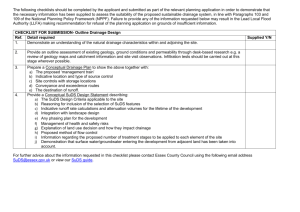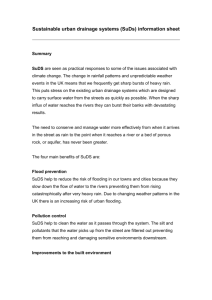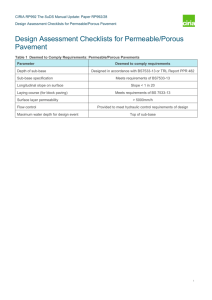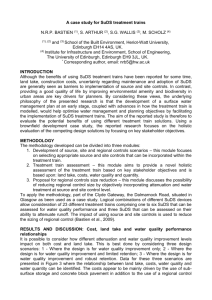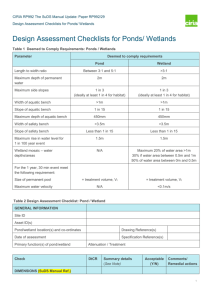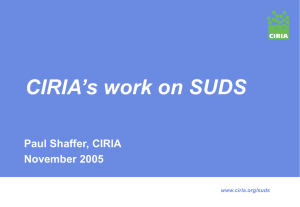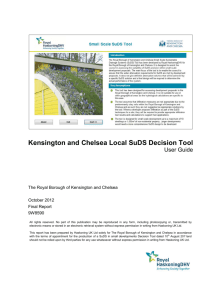The table below shows the SuDS solutions you are committing to
advertisement
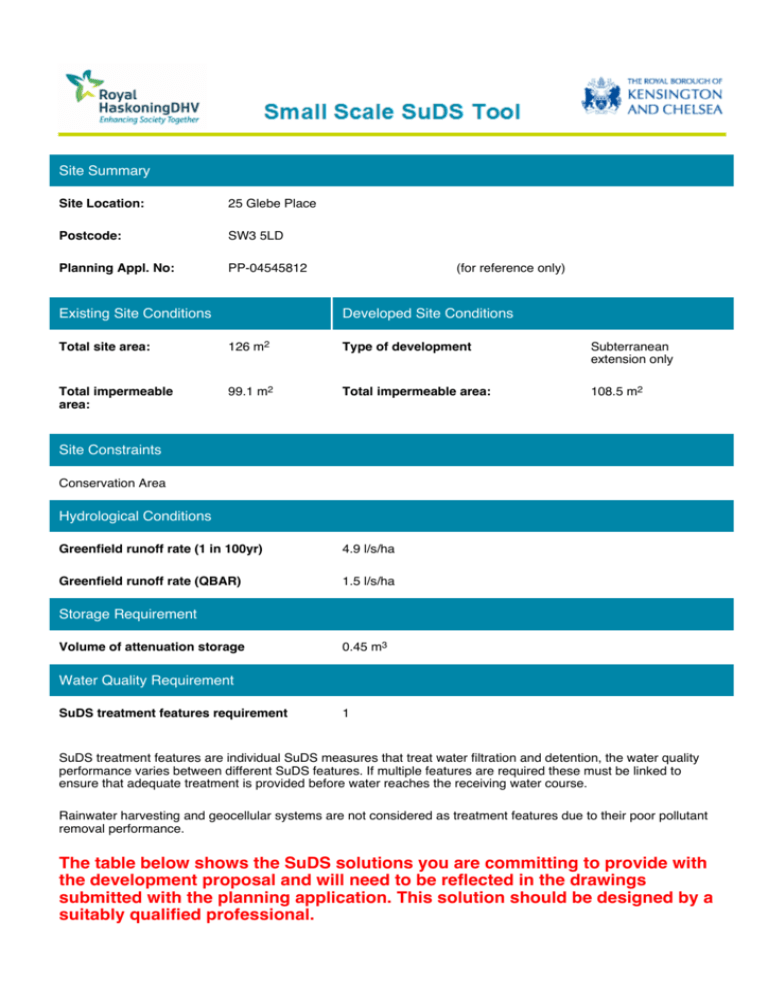
Site Summary Site Location: 25 Glebe Place Postcode: SW3 5LD Planning Appl. No: PP-04545812 Existing Site Conditions (for reference only) Developed Site Conditions Total site area: 126 m2 Type of development Subterranean extension only Total impermeable area: 99.1 m2 Total impermeable area: 108.5 m2 Site Constraints Conservation Area Hydrological Conditions Greenfield runoff rate (1 in 100yr) 4.9 l/s/ha Greenfield runoff rate (QBAR) 1.5 l/s/ha Storage Requirement Volume of attenuation storage 0.45 m3 Water Quality Requirement SuDS treatment features requirement 1 SuDS treatment features are individual SuDS measures that treat water filtration and detention, the water quality performance varies between different SuDS features. If multiple features are required these must be linked to ensure that adequate treatment is provided before water reaches the receiving water course. Rainwater harvesting and geocellular systems are not considered as treatment features due to their poor pollutant removal performance. The table below shows the SuDS solutions you are committing to provide with the development proposal and will need to be reflected in the drawings submitted with the planning application. This solution should be designed by a suitably qualified professional. Appropriate SuDS Solutions Rank Proposed Size of SuDS Options Potential Volume of Attenuation 1 Green Roofs May be inappropriate due to conservation area/listed building. m2 0 to 0 m3 1 Brown Roofs May be inappropriate due to conservation area/listed building. m2 0 to 0 m3 1 Rainwater Harvesting properties 0 to 0 m3 2 Permeable Pavements May be inappropriate due to conservation area/listed building. 9 m2 0.72 to 1.26 m3 2 Grass Pavements May be inappropriate due to conservation area/listed building. m2 0 to 0 m3 3 Geocellular Systems m2 0 to 0 m3 Proposed indicative volume of attenuation storage 0.72 to 1.26 m3 SuDS treatment features are individual SuDS measures that treat water filtration and detention, the water quality varies between different SuDS features. If multiple features are required these must be linked to ensure that adequate treatment is provided before water reaches the receiving water course. Guidance Green Roofs Green roofs comprise systems that cover the roof of a building with a vegetation cover over a drainage layer. They intercept and store rainwater attenuating flows and improving water quality. The water storage capacity is highly dependent upon site-specific considerations, however the main factors are vegetation cover, and the size of the drainage layer that the building can support. The range of indicative storage volumes suggested is based upon the impact of different types of vegetation cover in a typical situation. If the roof has the capacity to accept higher than normal loading its storage capacity could increase. Further information can be found in the SuDS Manual (CIRIA 2007) and the Environment Agency's Green Roof Toolkit. Detailed guidance on the design of green roofs for run-off attenuation has been developed in Germany by Forchungsgellschaft Landschaftsentwicklung und Landschaftsbau. http://www.ciria.com/ http://www.environment-agency.gov.uk/ http://www.fll.de/ RBKC accepts no responsibility for data held on other websites, the location of which may be changed by the third party without notice. Brown Roofs Brown roofs comprise systems that cover the roof of a building with vegetation cover over a drainage layer. They intercept and store rainwater attenuating flows and improving water quality. Brown roofs are similar to green roofs, sharing many of the same benefits and construction methods. However the focus is to deliver biodiversity benefits in terms of variety of species and habitat provision. The water storage capacity is highly dependent upon site-specific considerations, however the main factors are vegetation cover, and the size of the drainage layer that the building can support. The range of indicative storage volumes suggested is based upon the impact of different types of vegetation cover in a typical situation. If the roof has the capacity to accept higher than normal loading its storage capacity could increase. Further information can be found in the SuDS Manual (CIRIA 2007), the Environment Agency's Green Roof Toolkit and at BrownRoofs.co.uk. Detailed guidance on the design of green roofs for run-off attenuation has been developed in Germany by Forchungsgellschaft Landschaftsentwicklung und Landschaftsbau. Http://www.ciria.com/ http://www.environment-agency.gov.uk/ http://www.fll.de/ http://www.brownroofs.co.uk/ RBKC accepts no responsibility for data held on other websites, the location of which may be changed by the third party without notice. Rainwater Harvesting Rainwater harvesting involves storing rainwater that falls onto roof surfaces for use by the property owner. This can vary between relatively small water butts and more complex systems incorporating underground storage tanks. Water butts are not generally designed to provide storage of rainwater in extreme events and therefore cannot be included as part of the storage assessment for a site. This is the case because if they are already full they will not provide storage in any given rainfall event. Rainwater harvesting systems are generally larger and offer greater potential for management of storm water in addition to providing water for reuse within properties. The amount of storage that can be provided for dealing with storm water is dependent upon the system installed, however the SuDS Manual suggests that for a standard house the typical storm water component is 2m3 (CIRIA, 2007). http://www.ciria.com/ http://www.environment-agency.gov.uk/ RBKC accepts no responsibility for data held on other websites, the location of which may be changed by the third party without notice. Permeable Pavements Permeable Pavements allow a suitable surface for pedestrian or vehicle access while also allowing water to infiltrate through the surface into the underlying storage layers. Water can be stored in the underlying layers attenuating flows and allowing for water quality treatment. Examples include concrete block pavements and porous asphalt. The generally accepted guidance for the design of permeable pavements is provided by Interpave (Interpave, 2010). The design of permeable pavements is dependent upon the following factors: The loading that they need to be able to withstand If water is expected to infiltrate into the ground below the pavement or is stored and then transferred into either the next element of the SuDS treatment train or the surface water sewer system The level of the groundwater and whether this is a limiting factor for the depth of the pavement The amount of water that needs to be stored within the pavement. In the case of the Royal Borough of Kensington and Chelsea infiltration is generally not effective due to the geology. Therefore any permeable pavement needs to assume that water will not infiltrate into the ground and therefore all water must be accommodated within the sub-base layers. The range of indicative storage volumes suggested is based upon the range of typical arrangements for different loading criteria suggested by Interpave (2010). Permeable pavement systems typically can store water from adjacent impermeable surfaces in addition the the area which they occupy. Http://www.ciria.com/ http://www.environment-agency.gov.uk/ http://www.paving.org.uk/ RBKC accepts no responsibility for data held on other websites, the location of which may be changed by the third party without notice. Grass Pavements Grass pavements allow a suitable surface for pedestrian or vehicle access while also allowing water to infiltrate through the surface into the underlying storage layers. Water can be stored in the underlying layers attenuating flows and allowing for water quality treatment. The design of grass pavements is dependent upon the following factors: If water is expected to infiltrate into the ground below the pavement or is stored and then transferred into either the next element of the SuDS treatment train or the surface water sewer system The level of the groundwater and whether this is a limiting factor for the depth of the pavement. The amount of water that needs to be stored within the pavement. In the case of the Royal Borough of Kensington and Chelsea infiltration is generally not effective due to the geology. Therefore any grass pavements need to assume that water will not infiltrate into the ground and therefore all water must be accommodated within the sub-base layers. The range of indicative storage volumes suggested is based upon the range of typical arrangements for different loading criteria suggested by Interpave (2010). Grass pavement systems typically can store water from adjacent impermeable surfaces in addition the the area which they occupy. http://www.ciria.com/ http://www.environment-agency.gov.uk/ RBKC accepts no responsibility for data held on other websites, the location of which may be changed by the third party without notice. Geocellular Systems Geocellular systems are typically modular plastic systems with high void ratios that can be used to create below ground storage structures. They provide significant storage volumes and flow attenuation, however do not provide any of the other benefits of SuDS such as treatment, ecology or amenity. The SuDS Manual (CIRIA, 2007) states that geocellular systems should be designed in accordance with Sewers for Adoption 6th Edition (WRc, 2006). The typical void ratio for tanked systems is 0.9; therefore the storage capacity can be taken as 90% of the volume of the storage layer. The typical depths of storage tanks vary between 0.2m and 0.5m depending upon the product used. The range of indicative storage volumes suggested is based upon the range of systems avalable on the market. The amount of storage may be increased if products allow multiple layers to be used and there are no other site-specific constraints. http://www.ciria.com/ http://www.environment-agency.gov.uk/ RBKC accepts no responsibility for data held on other websites, the location of which may be changed by the third party without notice.
